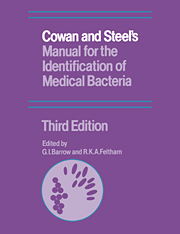Book contents
- Frontmatter
- Contents
- Foreword
- Preface to the first edition
- Postscript
- Preface to the second edition
- Preface to the third edition
- List of contributors
- Introduction
- 1 Classification and nomenclature
- 2 Culture media: constituents and sterilization
- 3 Principles of isolation
- 4 Bacterial characters and characterization
- 5 Theory and practice of bacterial identification
- 6 Characters of Gram-positive bacteria
- 7 Characters of Gram-negative bacteria
- 8 Taxonomy in theory and practice
- 9 Bacterial identification by cards
- 10 Bacterial identification by computer
- 11 Quality control in microbiology
- Appendices
- A Preparation and control of culture media
- B Staining: reagents and methods
- C Characterization tests
- D Test organisms
- E Preparation and use of Identicards
- F Use of computers
- G The Bacteriological Code
- H The Approved Lists of Bacterial Names
- I Reconciliation of Approaches to Bacterial Systematics
- J Glossary
- References
- Index
E - Preparation and use of Identicards
Published online by Cambridge University Press: 15 December 2009
- Frontmatter
- Contents
- Foreword
- Preface to the first edition
- Postscript
- Preface to the second edition
- Preface to the third edition
- List of contributors
- Introduction
- 1 Classification and nomenclature
- 2 Culture media: constituents and sterilization
- 3 Principles of isolation
- 4 Bacterial characters and characterization
- 5 Theory and practice of bacterial identification
- 6 Characters of Gram-positive bacteria
- 7 Characters of Gram-negative bacteria
- 8 Taxonomy in theory and practice
- 9 Bacterial identification by cards
- 10 Bacterial identification by computer
- 11 Quality control in microbiology
- Appendices
- A Preparation and control of culture media
- B Staining: reagents and methods
- C Characterization tests
- D Test organisms
- E Preparation and use of Identicards
- F Use of computers
- G The Bacteriological Code
- H The Approved Lists of Bacterial Names
- I Reconciliation of Approaches to Bacterial Systematics
- J Glossary
- References
- Index
Summary
Identicard set for genus identification
Use a card with a single row of holes (Fig. 9.1).
For the master cards, the key to the numbered holes for the characters is shown in Table El, and the plan for notching the holes in Table E2. All positive characters are notched from the hole to the edge of the card. For certain genera two or more cards may be needed to make provision for different reactions (‘dee’ characters) or differences in reading a test (e.g. catalase with Aerococcus). A guide card with the holes numbered or labelled is useful for the probing (sorting) operation.
Notching the unknown. Positive characters of the strain under test are notched from the appropriate hole (Table El) to the edge of the card.
Probing. When notching the card for the unknown strain is complete put it at the front of the pack of master cards, correctly faced, and test each hole in turn with a probe such as a knitting needle.
A probe through the hole of a positive character of the unknown strain will, when lifted, remove master cards that are negative for that character and these can be discounted. The card for the unknown strain and master cards of genera in which that character is positive will drop out of the pack; these cards are collected together and tested again for another character, and so on.
- Type
- Chapter
- Information
- Publisher: Cambridge University PressPrint publication year: 1993



